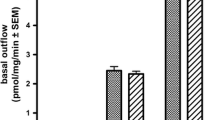Abstract
The aim of the present study was to determine whether exogenous radioactive GABA and glutamate previously taken up by rat brain synaptosomes are released preferentially with respect to the endogenous unlabeled amino acids. Preferential release was monitored by comparing the specific radioactivity of the amino acids released to that present in synaptosomes at the beginning and at the end of the release period. The GABA released spontaneously or by depolarizing the synaptosomes with high K+ in the presence of Ca2+ had the same specific radio-activity as that present in synaptosomes before or after superfusion. Depolarization with veratridine or superfusion with OH-GABA caused a moderate increase (15–20%) in the specific radioactivity of the GABA released and a corresponding slight decrease in that of superfused synaptosomes. In conditions causing a ‘supraadditive” release of exogenous and endogenous GABA (see ref. 13), the specific radioactivity of the GABA released was increased 20–30%. The GABA with higher-than-average specific radioactivity is probably representative of the cytoplasmic pool of this amino acid. The glutamate released spontaneously had a specific radioactivity lower than that present in synaptosomes at the start of superfusion, and also the specific radioactivity in superfused synaptosomes was lower than at the start of superfusion. The glutamate released by aspartate (by heteroexchange), by veratridine, or by high K+ had a specific radioactivity higher than that of the amino acid released spontaneously, similar to that present in synaptosomes at the start of superfusion, and higher than that found in superfused synaptosomes. These findings suggest that exogenous radioactive glutamate is released preferentially with respect to the endogenous amino acid and to the glutamate synthesized from glucose during the superfusion period.
Similar content being viewed by others
References
Cotman, C. W., Haycock, J. W., andWhite, W. F. 1976. Stimulus-secretion coupling processes in brain: analysis of noradrenaline and gamma-aminobutyric acid release. J. Physiol. (London) 254:475–505.
Haycock, J. W., Levy, W. B., Denner, L. A., andCotman, C. W. 1978. Effects of elevated (K+)0 on the release of neurotransmitters from cortical synaptosomes: Efflux or secretion? J. Neurochem. 30:1113–1125.
Sandoval, M. E., Horch, P., andCotman, C. W. 1978. Evaluation of glutamate as a hippocampal neurotransmitter: Glutamate uptake and release from synaptosomers. Brain Res. 142:285–299.
Sandoval, M. E., andCotman, C. W. 1978. Evaluation of glutamate as a neurotransmitter of cerebellar parallel fibers. Neuroscience 3:199–206.
Ryan, L., andRoskoski, J. R. 1975. Selective release of newly synthesized and newly captured GABA from synaptosomes by potassium depolarization. Nature 258:254–256.
Levi, G., Poce, U., andRaiteri, M. 1976. Uptake and exchange of GABA and glutamate in isolated nerve endings. Transport phenomena in the nervous system. Adv. Exp. Med. Biol. 69:273–289.
Levi, G., Banay-Schwartz, M., andRaiteri, M. 1978. Uptake, exchange and release of GABA in isolated nerve endings. Pages 327–350,in Fonnum, F. (ed.), Amino Acids as Chemical Transmitters, Plenum Press, New York.
Gray, E. G., andWhittaker, V. P. 1962. The isolation of nerve endings from brain: an electron microscope study of cell fragments derived from homogenization and centrifugation. J. Anat. 96:79–87.
Raiteri, M., Angelini, F., andLevi, G. 1974. A simple apparatus for studying the release of neurotransmitters from synaptosomes. Eur. J. Pharmacol. 25:411–414.
Raiteri, M., andLevi, G. 1978. Release mechanisms for catecholamines and serotonin in synaptosomes. Pages 77–130,in Ehrenpreis, S., andKopin, I. J. (eds.), Reviews of Neuroscience, Vol. 3, Raven Press, New York.
Levi, G., Roberts, P. J., andRaiteri, M. 1976. Release and exchange of neurotransmitters in synaptosomes: effects of the ionophore A23187 and of ouabain. Neurochem. Res. 1:409–416.
Levi, G., Rusca, G., andRaiteri, M. 1976. Diaminobutyric acid: a tool for discriminating between carrier-mediated and noncarrier-mediated release of GABA from synaptosomes? Neurochem. Res. 1:581–590.
Levi, G., andRaiteri, M. 1978. Modulation of γ-aminobutyric acid transport in nerve endings: Role of extracellular γ-aminobutyric acid and of cationic fluxes. Proc. Natl. Acad. Sci. U.S.A. 75:2981–2985.
Levi, G., andRaiteri, M. 1980. Mechanisms of GABA release and reuptake in presynaptic nerve endings. Pages 217–232,in,Levi-Montalcini,R. (ed.), Nerve Cells, Transmitters and Behaviour, Elsevier, Amsterdam.
Levi, G., Gallo, V., Ciotti, T., andRaiteri, M. 1979. GABA fluxes in presynaptic nerve endings from immature rats. J. Neurochem. 33:1043–1053.
Raiteri, M., Federico, R., Coletti, A., andLevi, G. 1975. Release and exchange studies relating to the synaptosomal uptake of GABA. J. Neurochem. 24:1243–1250.
Balcar, V. J., andJohnston, G. A. R. 1972. The structural specificity of the high affinity uptake ofl-glutamate andl-aspartate by rat brain slices. J. Neurochem. 19:2657–2666.
Levi, G., Gallo, V., andRaiteri, M. 1980. A reevaluation of veratridine as a tool for studying the depolarization-induced release of neurotransmitters from nerve endings. Neurochem. Res. 5:281–295.
Neal, M. J., andBowery, N. G. 1979. Differential effects of veratridine and potassium depolarization on neuronal and glial GABA release. Brain Res. 167:337–343.
Hamberger, A. C., Chiang, G. H., Nylén, E. S., Scheff, S. W., andCotman, C. W. 1979. Glutamate as a CNS transmitter. I. Evaluation of glucose and glutamine as precursors for the synthesis of preferentially released glutamate. Brain Res. 168:513–530.
Levi, G., Gallo, V., andRaiteri, M. 1980. GABA potentiates the depolarization-induced release of glutamate from cerebellar nerve endings. Pages 127–138,in,Di Chiara,G., andGessa,G. L. (eds.), Glutamate as a Neurotransmitter, Raven Press, New York.
Author information
Authors and Affiliations
Rights and permissions
About this article
Cite this article
Levi, G., Banay-Schwartz, M. & Raiteri, M. Studies on the release of exogenous and endogenous GABA and glutamate from rat brain synaptosomes. Neurochem Res 6, 275–285 (1981). https://doi.org/10.1007/BF00964043
Accepted:
Issue Date:
DOI: https://doi.org/10.1007/BF00964043




